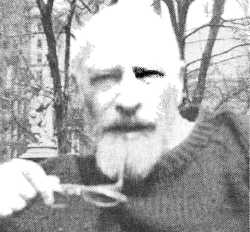Ward Moore facts for kids
Quick facts for kids
Ward Moore
|
|
|---|---|

Ward Moore c.1973
|
|
| Born | Joseph Ward Moore August 10, 1903 Madison, New Jersey, USA |
| Died | January 29, 1978 (aged 74) Pacific Grove, California, USA |
Joseph Ward Moore (born August 10, 1903 – died January 29, 1978) was an American science fiction writer. Even though he didn't write a huge number of books, many of his stories became very popular. People often call his books "classics" in the science fiction world.
Contents
Ward Moore: A Science Fiction Author
Ward Moore started his writing career with a novel called Breathe the Air Again in 1942. This book was about the start of the Great Depression, a tough economic time. The story was told from different people's points of view. Interestingly, Ward Moore himself even appeared as a small character in the book!
His Amazing Stories
Moore is best known for his exciting alternate history novel, Bring the Jubilee (1953). In this type of story, the author imagines what if a major historical event had turned out differently. In Bring the Jubilee, Moore explores a world where the Southern states won the American Civil War. This left the Northern states in ruins.
Famous Books
Ward Moore wrote several other interesting novels. Cloud by Day tells the story of a town threatened by a big brush fire. Greener Than You Think is about a type of grass that just won't stop growing!
He also wrote books with other authors. Joyleg, co-written with Avram Davidson, imagines that an old American state called the State of Franklin still exists. Caduceus Wild, written with Robert Bradford, describes a country ruled by doctors.
Short Stories to Read
Moore also wrote many short stories. Two of his famous ones are "Lot" (1953) and "Lot's Daughter" (1954). These are postapocalyptic tales, meaning they are set after a huge disaster. They have themes similar to stories found in the Bible.
Another well-known short story is "Adjustment." In this tale, an ordinary man finds himself in a magical land where his wishes come true. He learns to make the world around him change to fit his desires.
His 1951 story Flying Dutchman is also a post-apocalyptic story. It uses the legend of the Flying Dutchman, a ghost ship doomed to sail forever. In Moore's story, it's about an automated bomber plane that keeps flying over Earth. Humanity and all life on Earth have long been destroyed by a nuclear war.
Ward Moore's Life Journey
Ward Moore was born in Madison, New Jersey, a town near New York City. His parents were Jewish and had married the year before he was born. When he was a baby, his family moved to Montreal, Canada, where his mother's family lived. They moved back to New York in 1913.
Early Life and Education
Moore's parents later separated. His father passed away in 1916. His mother then married Julian Fuhs, a famous German jazz band leader. Ward Moore went to De Witt Clinton High School in New York. He left school early, saying he wanted to focus on writing. He later attended Columbia College for a time.
In his early twenties, Moore traveled a lot around the United States. He even worked in a bookshop in Chicago for a while. There, he became friends with a young poet named Kenneth Rexroth.
Becoming a Writer
In 1929, Moore moved to California, where he lived for the rest of his life. In 1937, he joined the Federal Writers Project. This was a government program that hired writers during the Great Depression. His first novel, Breathe the Air Again, was about the lives of workers in California. It included parts of his own life and was well-liked by critics. He planned for it to be the first of three books, but the others were never finished.
During the 1940s, Moore wrote reviews for books, articles, and short stories. His work appeared in magazines like Harper's Bazaar and newspapers like the San Francisco Chronicle. He married his second wife, Lorna Lenzi, in 1943. He had seven children. From 1950, he worked as a book review editor for a political magazine called Frontier.
In the early 1950s, he started writing regularly for The Magazine of Fantasy and Science Fiction. He became good friends with the magazine's editors, Anthony Boucher and J. Francis McComas. His science fiction stories were fun and well-written, and readers really enjoyed them.
Later Years and Family
In the 1960s, Moore wrote less. His last two novels were finished with the help of other writers. His 1953 novel, Bring the Jubilee, became popular again around the 100th anniversary of the Civil War. Many Civil War fans discovered and enjoyed it.
He published only a few stories in the 1960s, but he wrote several more in the mid-1970s.
Ward Moore later married his third wife, Raylyn Moore, who was also a science fiction writer. They moved to Pacific Grove, California, where he passed away in 1978.

